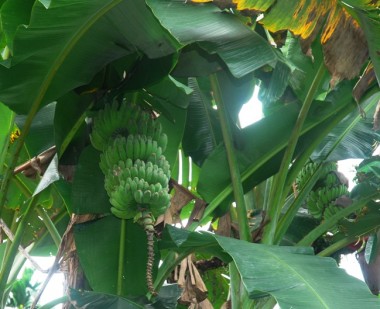Jan 19, 2015
Hot Weather's On The Way
A bird seldom seen, though by no means rare, is the Green-billed Malkoha, Phaenicophaeus tristis. It is a jungle bird as can be seen by its habit of hopping and jumping around branches in a tree. In fact sometimes it 'runs' up a tree in a series of hops much like a squirrel.
The Malkoha has been a resident in our farm for a few years now. We were surprised to see this individual building a nest in one of our fruit trees right next to a busy farm road. It seems absolutely perturbed by our presense as it goes about gathering twigs and leaves for its nest. It must be at least 3rd generation farm-born to show this level of confidence.
We designed and maintained our farm as a sanctuary for wild-life, even predators. We hope to demonstrate that it is possible to farm and yet co-exists with Nature.
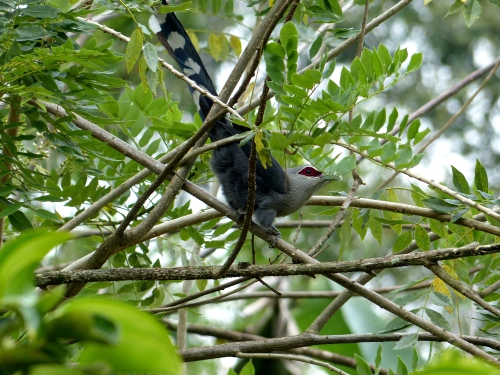
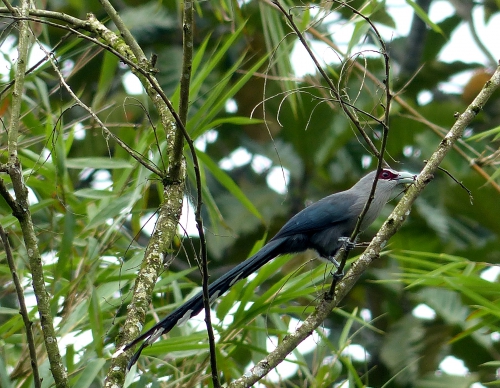
Here's a video we took of it hopping around a dead tree gathering twigs:
19:22 Posted in Blog, Sustainable Farming | Permalink | Comments (0) | Tags: phaenicophaeus tristis, green-billed malkoha, rare birds, malkoha, non-parasitic cuckoo
Apr 16, 2013
Free-Range Egg Model for Rural Farmers
This is the free-range layer model we intend to implement as a social enterprise with rural low-income farmers. If they sell the eggs themselves at the Farmers’ Market, each egg should fetch rm1.00 each. We will supply them 200 pullets that are close to laying unlike what is happening now when the poor farmers are given day-olds and in no time, disease will wipe out all the birds.
At the very least, the farmers can expect an income of between rm2500 to rm3000.00 per month.
We will be starting with five farmers in Pahang.
13:50 Posted in Blog, Chickens, Nature Farming, Permaculture, Sustainable Farming | Permalink | Comments (1) | Tags: free range egg laying model, free range eggs malaysia, organic eggs malaysia
Apr 15, 2013
Sights And Sounds Of The Farm - Emerald Doves
Emerald Doves are usually very flighty and nervous near humans due to poaching. At our farm, they are resident and are found in many nooks and corners. Many times they will just swagger off, in a pigeony way (which they are) when they see us. Here's one that's just in front of our workers' quarters. The video of it feeding in our garden captures the sounds of the farm at around 11 am, mid-morning. If we hadn't tell you, you would think the video is in the forest with the myriad sounds of birds and insects. But that's what we are trying to achieve in our farming - that we can be commercial and yet be in harmony with Nature.

Here's a recording of the sounds that you will hear at our farm. You would be forgiven if you think you are in the jungle.
16:12 Posted in Blog, Permaculture, Sustainable Farming | Permalink | Comments (0) | Tags: emerald dove, nature farming, permaculture, sounds of tropical forest, punai tanah
Mar 15, 2013
The Yellow Birdwing, Troides helena, is now a resident
On the 1st day of this year we saw for the first time a single female Yellow Birdwing, Troides helena, flying fast at the perimeter of our farm, as if making an aerial survey.

From a distance, it looks like a bird
The Yellow Birdwing is protected by law and is becoming difficult to see in the wild due to loss of habitat and due to collectors.

The female zooming past us on the 1st of January, 2013
Just barely 2 1/2 months later, they have made our farm their home. They are breeding and have become a familier sight. And interestingly, they show no fear of us. Also of interest to us is the fact that the farm has a larger share of birds than other places and yet they choose to breed here.
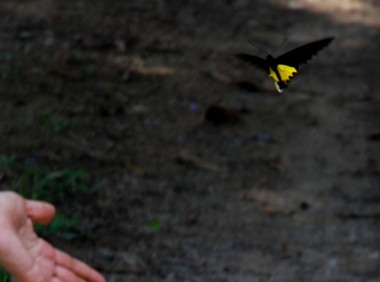
They show no fear of us
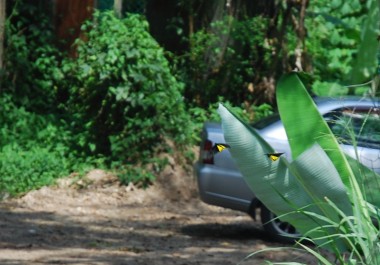
You won't find wild birdwings flying around your cars!
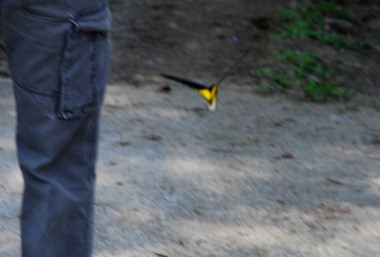
Flying close to us without fear.
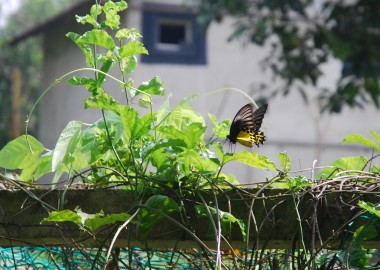
We leave fruits to ripen on the trees for birds and butterflies. Our workers are instructed not to feed nor to disturb nor to stare at the birds, and also the butterflies. We make as if they are non-existent. We plant their larval plants and we plant flowering vines that will bloom up in the canopy for the butterflies. And above all, no poison, no chemicals. We co-exists, and they so enrich our lives as farmers.
18:18 Posted in Blog, Nature Farming, Permaculture, Sustainable Farming | Permalink | Comments (0) | Tags: common yellow birdwing butterfly, troides helena, rare butterflies
Nov 12, 2012
When Nature Gives Feedback
Amorphophallus prainii will go dormant for months. And just when you thought they have died or something, suddenly they start sprouting all over the place.
They love soil with lots of organic matter, 'living' soil. And we are sure there’s a relationship between them and microbial life as we find the ‘wilder’ the spot, the more they sprout.
Our farm must be entirely 'wild', being free from chemicals for two decades now. And recently due to constant rain, they started sprouting all over the place.
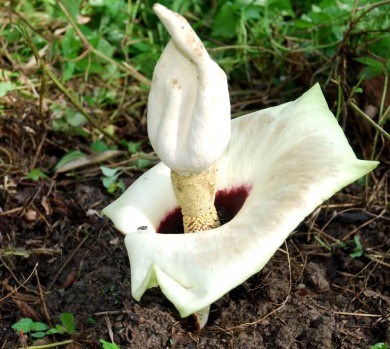
Said to be uncommon, but it seems to be found everywhere in the farm. We counted close to a 100 of them.
The corm or tuber has been used for food, but it has to be treated properly as it is high in calcium oxalate and can cause you to have a severe choking reaction.
Researchers have found that it can destroy cancer cells in rats, and also it can repair damaged liver cells.
Research paper on hepatoprotective activity
Research paper on cytotoxic activity

Extract from the corm have shown hepatoprotective and cytotoxic activity.

The plant before it dies back and go dormant or rarely, it will send out a blossom.
17:42 Posted in Blog | Permalink | Comments (4) | Tags: amorphophallus prainii, pokok ubi lekir, loki, ubi kekek, calcium oxalate, cytotoxic plants, hepatoprotective plants
Sep 01, 2012
Animal Feedstock - localise it
There is this mental block that we have to have corn for animal feed. So Malaysia try to grow corn for feed but it did not work out too well - not if you are competing with heavily subsidised imported corn. Further, corn and soya are termed 'commodities', ie it means people are allowed to speculate on its future price. For farmers that means your future is influenced by speculators. For small countries like Malaysia, that means our food security is in the hands of big spending speculators. Hey, that's not a comfortable position to be in, and really I often wonder why we allow ourselves to be dragged into such a precarious position.
So, recently due to droughts in USA, speculators have jumped in and the price of corn and soya has gone through the roof. Farmers are dying because suddenly more cash is needed, practically overnight, to feed the animals. Consumers are shouting because suddenly meats are more expensive.
One of the ways local small farms can get off the carousel is to grow feedstock that is indigenous to local climate and which require as little input as possible.
At our farm, we use cooking bananas. All imported feedstock corn is GMO. Our bananas are not.
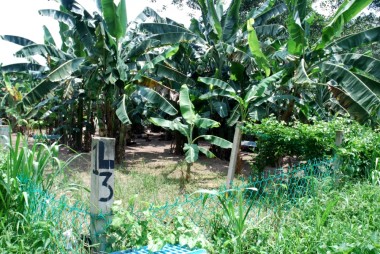
All our chicken fields are planted with these bananas

They are tall trees, up to 25ft, with large shade areas. The fruits are higher in energy values than corn.
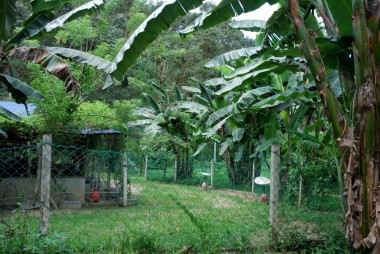
Because of their height and large shade area, we plant them to block off west-side sun, thus saving on artificial cooling costs.

They also play an ecological role by absorbing nutrients from waste water since they are water-resistant.
They produce more feedstock per acre of land than corn.
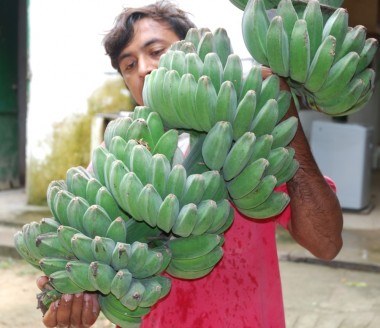
Each bunch is about 20 to 30kg

They store well, and can be readied for feedstock in a jiffy
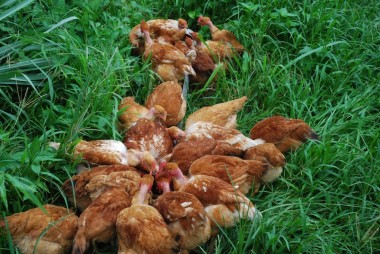
Chickens love the bananas and make a mad rush for them when presented.
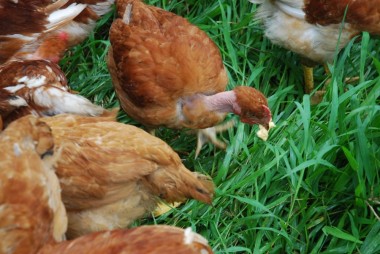
Bananas do not have the high omega 6 that corn has and thus produce a healthier meat for human consumption. Corn not only have high omega 6 but also is practically 100% GMO now.
10:31 Posted in Blog, Permaculture, Sustainable Farming | Permalink | Comments (0) | Tags: feedstock, increasing food costs, corn, soya bean, drought, cooking banana, bbb musa, local feed ingredients
Jul 22, 2012
Forest In A Farm
Twenty years ago, we started to plant forest trees in a zone within the farm. Today, some of the trees are 100 feet tall, and of course, still growing. We plan now to develop this zone into an area of bio-diversity and hopefully, some of the animal life driven off by logging uphill, will instead make this zone their home. The forest uphill was home to siamang, wild cats, and many more.
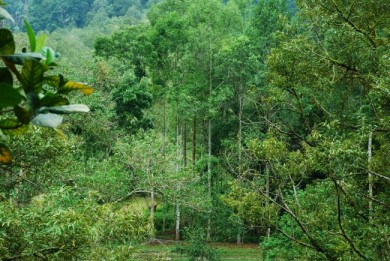
Canopy trees in a farm!

Meranti

Pulai
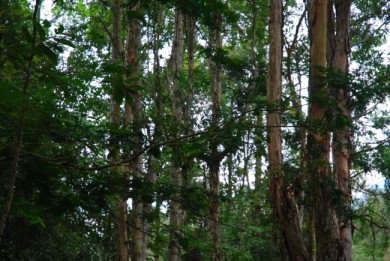
Gelam

Kasai
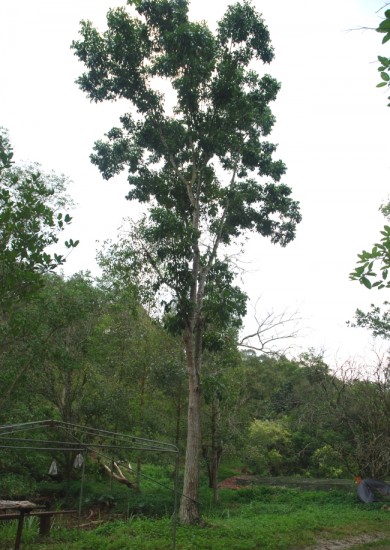
Mahagony
Sustainable agriculture is long term, planning decades ahead, not months or weeks.
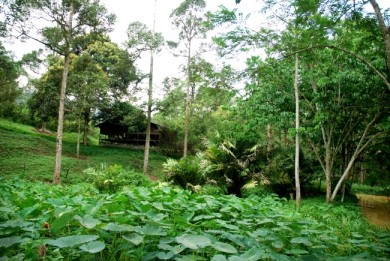
At one end of the zone is this beautiful location, perhaps a suitable site for a Sustainable Agricullture Institute.
08:02 Posted in Blog, Permaculture, Sustainable Farming | Permalink | Comments (0) | Tags: agro forestry, permaculture, meranti, nyatoh, pulai, rain trees
Jun 28, 2012
Farewell to my friends....
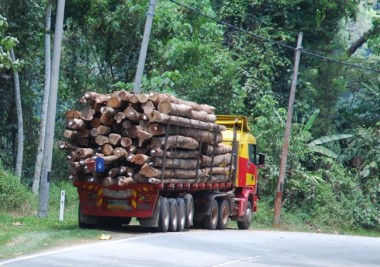
Saw this lorry with freshly harvested logs parked near the farm. Shocked, I found out that they are harvesting the trees at the back of the farm next to the forest reserve.
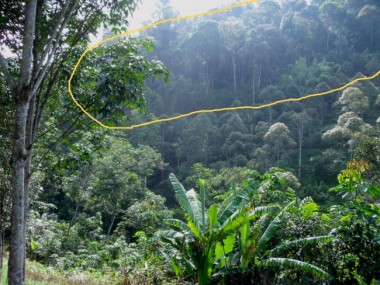
This is the area they are logging. I have wandered there since 1991 and I know practically every tree there. Some are easily 150 years old.

Another view of the area being logged. Up till today I cannot understand the economics of logging and how it benefits the people. Through our Government which represents our desires and wishes, we will get a royalty payment, I think for each tree. How much are we getting? RM5000 per tree? RM10,000 per tree? It is a one-off thing. After that, what? Wait another 150 years for the forest to recover and grow trees like that?

The loggers moved fast. Within a week, they have marred the hillside. No notification given to neighbours, no consultation, no EIA reports.
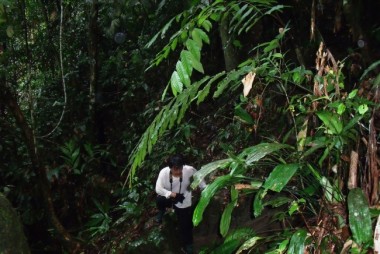
Me, inside the jungle, with my friends, the trees. Farewell my friends. There's nothing I can do since 30 million Malaysians want you guys to be chopped down.
20:14 Posted in Blog | Permalink | Comments (0) | Tags: economics of logging
Jun 01, 2012
Eat More Plants...
I am wary about juicing vegetables, especially modern vegetables. They have been hybridized to grow too fast, and too ‘sweet’ and ‘juicy’. It is like broiler chickens – they are hybridized to grow fast and to develop large breasts.
Our tests have shown a change in the nutrients content of the broiler meat due to changes in dietary requirements to meet its fast growing nutritional needs. For example, saturated fats and omega 6 content sky-rockets, making it an ‘unbalanced’ meat, whether organic or not.
The same must apply to modern hybridized vegetables and fruits. They require more nitrogen for one. What happens to all these nitrogen in the plants, and what happens to us when we consume these day in and day out? And when they grow so fast, do they really have the time to absorb all the micro-nutrients in the soil that our body needs? Again, it does not matter whether the plants are organic or not. A fast growing plant is a fast growing plant and have the same nutrient requirements, whether organic or not.
For me, plants are essential for our health. So, for juicing, I juice PLANTS, not necessarily vegetables.
Here’s a plate of leaves and flowers that I use to juice:
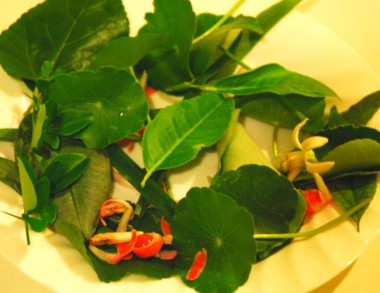
(Click on pics to enlarge)
Leaves and flowers of plants which do not contain anti-nutritional factors like oxalates, which are slow growers, which have been tested in laboratories to have high antioxidants, etc.
Here’s to your health – juice of PLANTS (not vegetables).
11:26 Posted in Blog, Slow Food / Rare Receipes | Permalink | Comments (2) | Tags: juicing of vegetables, juicing of leaves, juicing of plants, pegaga, bunga kantan, lemon flower, red ginger, cekur
May 19, 2012
Eggs - What's That Wiggly Thingy?

A store is no longer stocking our grassfed, free range eggs because a couple of their customers complaint about that 'wiggly thingy' found in our eggs, and that obvious round disc on the egg yolk.
Well, if we were the store owner, this is what we would say to the customer:
1. We try to give our hens as natural a life as possible. This includes plenty of space to roam, grass to eat, and surprise, surprise, a 'husband'. So, as is normal when wives and husbands get together, eggs get fertilised and babies are born. So that disc on the yolk is a fertilised germinal disc, or blastoderm. Unfertilised eggs will have just a speck. Fertilised eggs will have a disc. And we promise you, eating fertilised eggs will not make you more manly and sprout whiskers, nor will it make you pregnant, nor will it make your unborn baby develop 'chicken brainism', a brain disease of unknown origins.
2. And that wiggly thingy is the chalazae, made of the same material as the white of the egg and intended to hold the yolk in place. Chalazae is prominent in the freshest of eggs. It dissolves and disappears as the egg ages. So, dear customer, the eggs with absolutely no chalazae that you have been eating are clearly not fresh inspite of the words printed in bold on the label, Farm Fresh. 'Chicken Brainism' is a disease common amongst modern consumers and we have no idea where the disease comes from but we can assure you it does not come from eating fresh eggs from hens that are allowed to lead as natural a life as possible.
12:10 Posted in Blog, Chickens | Permalink | Comments (0) | Tags: organic eggs, free range eggs, blastoderm, chalazae








